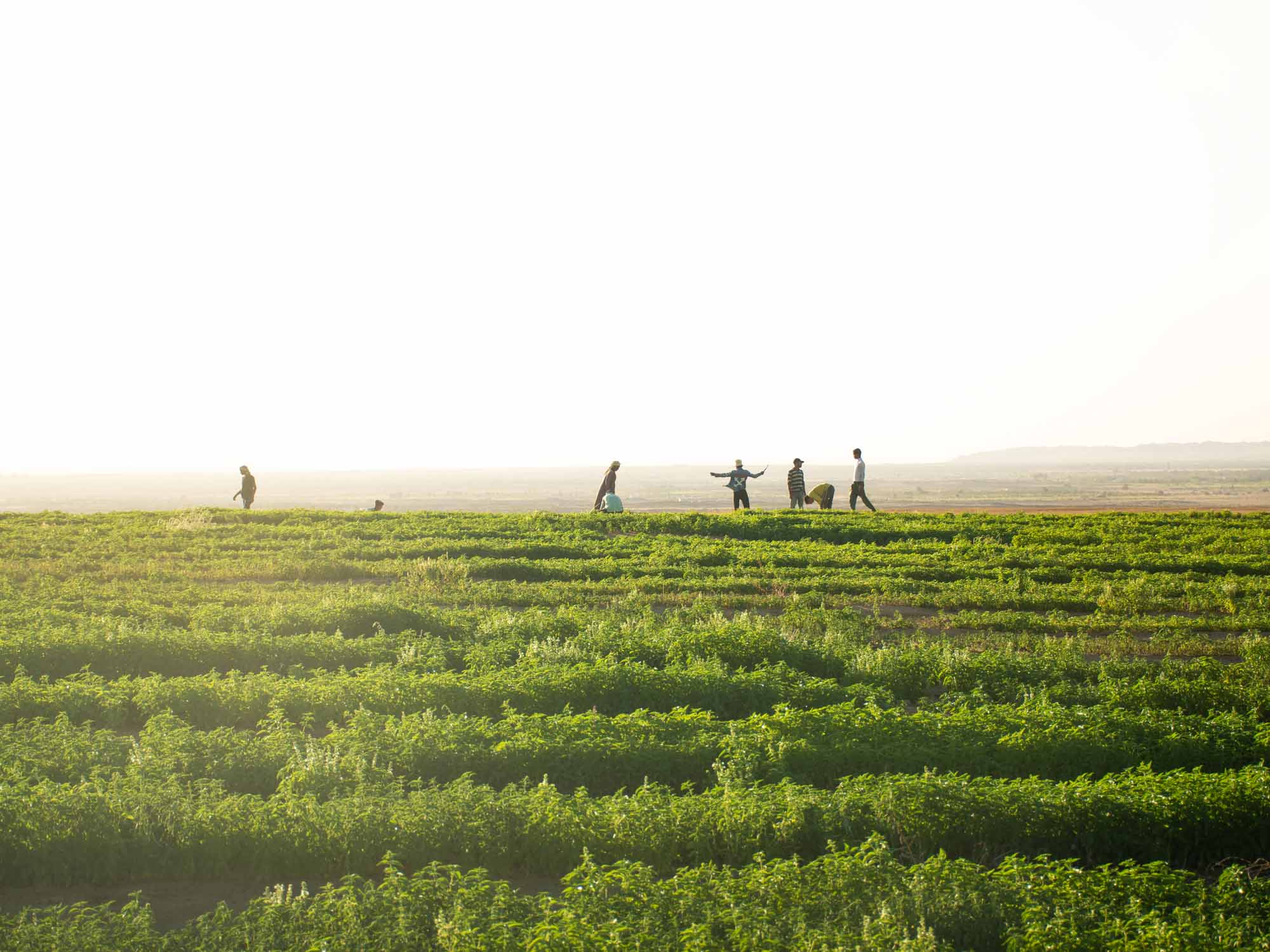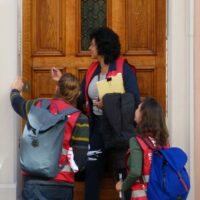Andrea Valdinoci was in Sekem, Egypt in early October as a board member of the Evidence Foundation. Impressed by the power of initiative of the place and the people, he spoke with Helmy Abouleish about Sekem’s vision. Here the goal is not only Biodynamic Agriculture, but systemic change and transformation of our consciousness so that the coexistence of human beings and nature becomes possible.
Andrea Valdinoci: I am very touched by what you have built in Sekem and Wahat. Seeing how Mohamed, the farm manager in Wahat, manages the 1000 hectares, and how it is possible to grow a variety of crops so quickly in a complete desert landscape, was not only filled with hope but very touching. And such a person is not only a farmer but knows various things about the land, can answer everything about plants and then furthermore holds midday prayers for his staff. What you have built here is also a new opportunity for many people. Sekem farm offers a wide variety of educational opportunities: from kindergarten to the young people who can do metal training, from high school to teacher training. Thank you very warmly for this powerful impulse for the world and for reporting here today on what you are doing and planning. These days you said: «Sekem will only exist if we change the whole system. That is everything from banks to politics.» Can you explain this a bit more?
Helmy Abouleish: The dream my father had when he founded Sekem in 1977 was the dream of a systemic change in Egypt. By systemic change, I mean a change in all four dimensions of life: culture, economy, social affairs and nature. A systemic change for an economy that truly serves people, enables everyone involved to develop their potential, meet their needs, and live a life worth living. The products or services that come out of this should of course be really healthy and in harmony with nature and society and enable the individual to develop through these products. The same can also be said for the cultural sphere. Because if you look at Egypt then and look at Egypt even more now, you will see that the education system, including the universities, research and the cultural landscape need this systemic change. But always centred on the fact that it is about the development of the human being, the development of consciousness; that from birth to death and in every situation there must always be a chance for us to learn, develop and evolve. It is about this divine light, as Islam so beautifully puts it, that rests in each of us. And the same applies to society and in the social sphere. Especially when you look here from the West, you have the feeling: ‹They are far behind us and don’t have this wonderful democracy›. That may be true in many respects, but we must not forget: every form of society is the result of the consciousness of the people who live in that society, a mirror, we might say, of that consciousness. Therefore it is actually about working on this consciousness in order to change society. However, if you try to apply to such societies the forms that fit another consciousness, for example, the West, it does not work. You can see that immediately, too. And I think the West today also has to ask itself what is appropriate for a new consciousness as a political or as a social format. In that sense, the dream my father had was that we can develop forms of society appropriate to people’s development potentials, where we treat each other with respect, appreciate and love each other. But also to realise that the possibility of a community contributing something to the world is much greater than you can ever manage on your own. ‹One and one are ten› – that is our experience in Sekem. How do I get to the point where the synergy between the two of us makes it possible to achieve more than either of us can at best achieve alone? And to do this on the basis of a truly mindful approach to nature? Perhaps even with the aspiration of being able to give nature an impulse in its development, not only to preserve it but to develop it? That was my father’s dream and he always said that it would take time. Such a development does not happen overnight because it occurs in people’s hearts and minds. With such an aspiration it was clear from the beginning: the ultimate goal is not that we should have a beautiful enclave here, a farm, biodynamic agriculture and a number of people who can live a different life. Sekem was always meant as a model. Since 2017, when my father died, we have been thinking about how to integrate these models into society in such a way that the seven million farmers and the 1.6 million teachers and the 1.3 million state employees can participate. This is a new challenge because you cannot wait until everyone understands what we are doing. We translate into their language and that provides the opportunity to understand our ideas. Even if we don’t always agree, in order to bring about a systemic change in the economy, in a world that only ever thinks about profit and prices, you have to use these tools to enable others to get in. Then, over time, with the right guidance and focus on lifelong education, potential, development and cultural opportunities, something will also happen in the souls and heads of these people.
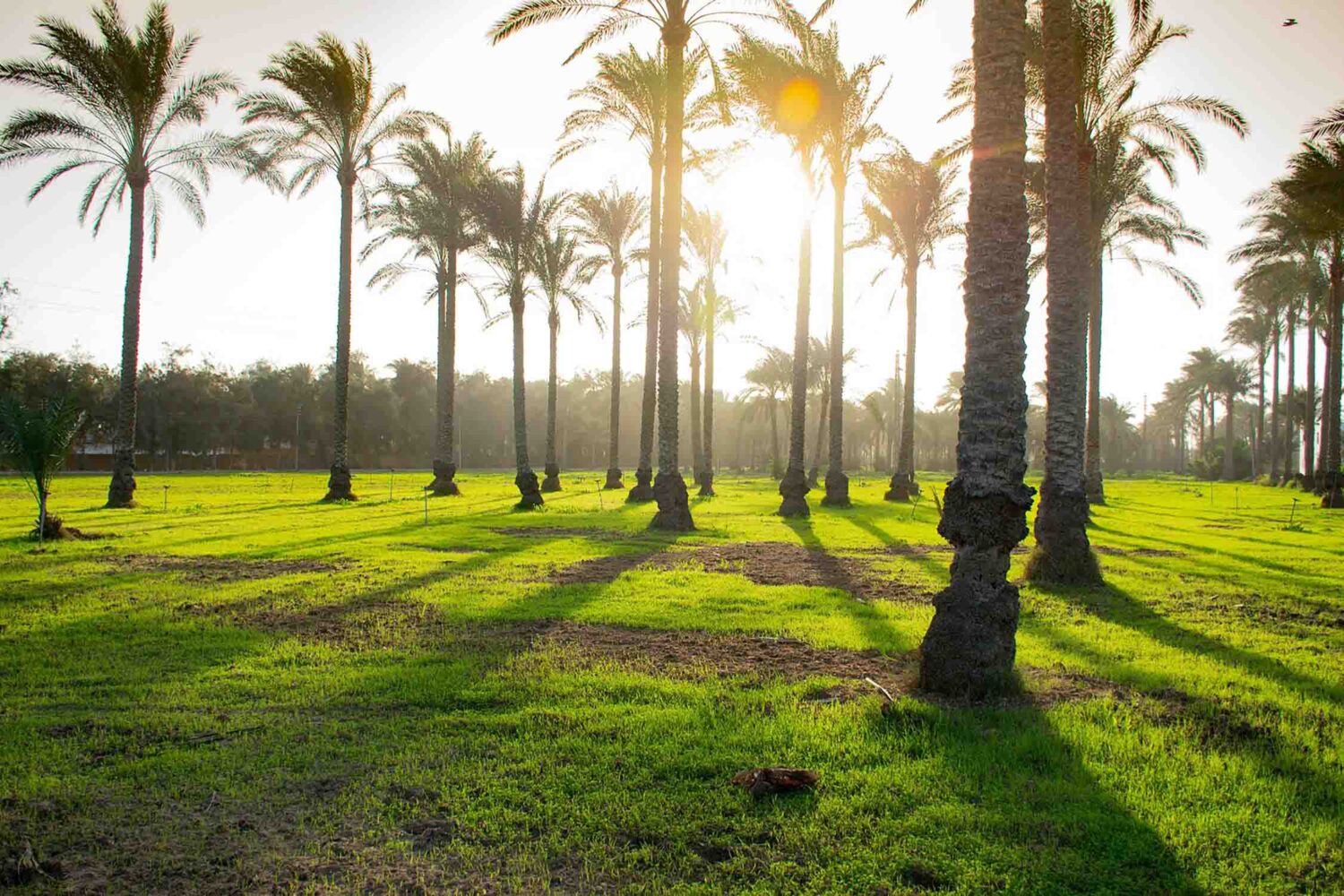
Valdinoci: Here on-site there are about 2000 people working. More than 2500 hectares are cultivated in total. Can you give us a little more of an overview?
Abouleish: We farm 2500 hectares, but we cooperate with farmers in our Egyptian Biodynamic Association who farm a total of 20,000 hectares. In this rapid scaling we are engaged in right now they are naturally increasing, and members are doubling each year. We hope that in the next three years we will work with 40,000 organic and Biodynamic farmers whom we are helping to convert so that we can really be involved in the conversion of the 100,000, 120,000 or 150,000 hectares. The idea, of course, is not that they should all be suppliers of raw materials to Sekem but that they should sell organic products for the normal market price to all the villages and towns in Egypt and around.
Valdinoci: I came here thinking that agriculture is actually the main topic. That is true, but in a way, it’s also not. I see how many companies are active here, what you do in the field of education, what you do on the governance level when you introduce your own eco-label in Egypt or when you talk about Bedouin law, which still exists here, and how you deal with it. Or even the whole idea of giving away Sekem Holding, turning it into a foundation and creating ownership of responsibility. These are all innovations you are carrying out here at various levels of society. How do you sustain that, how do you get that sorted? What kind of qualitative support do you actually need?

Helmy in a Word
Moments of Happiness: Having implemented the Carbon Credits for Future in Egypt in such a way that in the future all organic farmers will be able to get about 35% more yield from their work through composting, tree planting, and soil management and compete with conventional prices. Supplying approx. 70% of the domestic herbal tea market (conventional and organic) with the Isis company. Approval in 2020 to expand Heliopolis University from five to twelve faculties.
Moments of despair: On the Wahat Sekem farm almost all the trees that had been planted at the beginning were uprooted twice. Seeing how many students are trained to say what the professor wants to hear.
Greatest Challenges: Significantly reducing the Sekem Group’s debt burden over the next three years (currently approx. 25 million euros) and bringing it to zero by 2033. Helping to facilitate sustainable transformation in the various sectors for the whole of Egypt.
Image: Andrea Valdinoci (left) with Helmy Abouleish
Abouleish: The Sekem impulse is a holistic development impulse. Organic farming is of course the best basis for this that one could wish for. But it is only one dimension and you have to include threefolding in your thinking. You have to constantly include all areas as much as possible in your thinking in what you do – balance and develop them so that they remain in harmony or at least in motion. At every point, you must dare to question what exists at any given moment and look at what the appropriate form of architecture, money, health care and so on will be in the future. If you just do that consistently, ask yourself every day, ‹What am I doing right now? Is this what I want for the future, for all people and also the next generations to do?›, you constantly come up against questions, and challenges and have to make the effort to think: ‹How do I reinvent something now? How do I build on the experience of others in particular areas to change things?› This irrepressible will and desire for change within us, we also nourish it by meeting early every day in the morning circle, by educating and inspiring ourselves spiritually, by asking ourselves every day in every area: What shall I do in a new way? This is especially difficult when you are doing well because then you naturally become more comfortable and no longer feel this irrepressible desire for change. But that is precisely when it is important.
And it takes the courage not only to consider, discuss, and explore, but also to take action. To really try it out in a place where you might still have a lot of questions. But to take the next step, to trust your own hands and feet as much as your head and heart, is important. Most of what you learn is in the movement of life, not in sitting and thinking about it. What we have found most helpful over the last 45 years and what we also need most is a network, friends, and people with whom we can exchange ideas. People who help us to start in different places and accompany us to implementation when it comes to founding a school or a hospital or a university or a company or whatever. We are blessed by fate with a large network and friends all over the world and in different areas in which we work. That is also what we need most for the future. People follow an idea with enthusiasm and love. Most of the other factors that you also need, like money and materials, come after the idea.
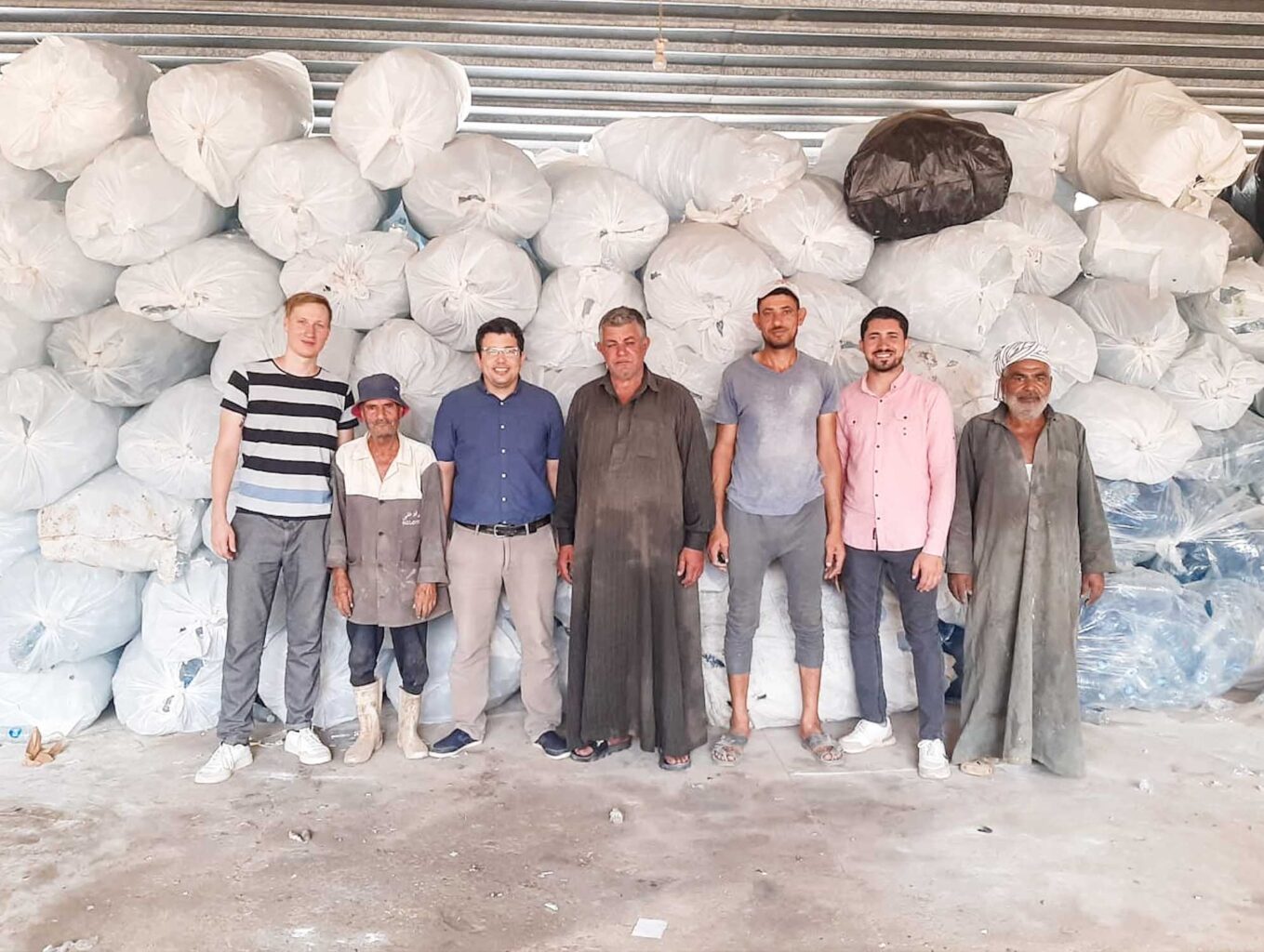
Valdinoci: I have observed that. I was allowed to see a small rehearsal here in the theatre, where the topic was biodiversity. You have set yourselves various goals by 2057. You always pick two for the year and work on them with all the people who work here, including the theatre. Can you say how the idea came about that you go into the villages with a waste collection and give the people a bit of money to separate the waste?
Abouleish: In 2017 our question was: How can we take what we have here in terms of ideas into society to an even greater extent? How can we in the first instance translate our ideas into a language that people understand and then scale them? Here we naturally also asked what Egypt would look like if we managed to do that. So what would Egypt look like in 2057 if we went out with the fields and the ideas we have developed here? Can other people implement them, perhaps even better than we can? A beautiful image arose for Egypt: a country where one hundred percent organic agriculture is practised, where all educational institutes are dedicated to the development of potential, of individuality, throughout life. An Egypt in which all companies implement in their form what we have developed as principles for an economy of love. Or it is an Egypt where the political, legal and social forms involve the people in such a way that everyone feels: this is my Egypt. I am a part of it and I help shape the future. This resulted in sixteen Sekem Vision Goals for Egypt. We have set out on the path in the four areas of sustainable development, that is, in the ecological, economic, social and cultural spheres. We cannot work on all sixteen goals at the same time. This is not possible in terms of capacity and people’s ability to focus. To begin with, we want to go through all sixteen once in the first ten years, by 2027. Because we have this wonderful tradition here of meeting twice a year with all our divisions for a seasonal festival, we have decided to work on one of these sixteen mission goals for each seasonal festival. For us, working on them means first of all making ourselves aware of what it means when I talk about one hundred percent organic farming. Or what it means when I talk about improved biodiversity? What is biodiversity in the first place? What are the risks? Where are we with things, looked at from various sides and with the greatest possible involvement and contribution of all people? It really matters to us that everyone at every position in Sekem is involved in this process. Because if we don’t manage it in Sekem, who will manage it in the world? This is a process that takes six months. Towards the middle of the year, it is then a matter of asking what concretely needs to be done.
And it became clear pretty quickly that the Egyptians cannot cope at all with the waste that you see everywhere when you drive through the country. One hundred and ten million Egyptian people with 42 kilos of waste per capita and year, that is of course a huge amount and there is no system at the moment that can deal with it. From the city to the countryside, there is rubbish on every street, piles of rubbish are burned. So we started to address the waste issue. How can it be reorganised? We first tried things out with ourselves here. Then, of course, with Heliopolis University. We then saw that there were a lot of possibilities. Even if all you do is separate organic and non-organic waste at source, you create added value. This can be given to the people – instead of a villager here giving money to a company that picks up the collected waste, separates out a few valuable things, sets fire to the rest at the roadside and thus sends the dioxin back into the house. Then you can help people to separate it, turn their organic waste into compost and sort all the other components of their waste so that they can sell them and process what is left over so that it can at least serve as fuel for industries. So that’s what we tried. And it worked. At the moment we are scaling up in the 13 surrounding villages. It is, of course, again quite a simple model because we say to the family: instead of paying money for waste collection, you get money if you separate well. We hope that in this way we will find a way to scale this model, establish it around us and then see how we can bring this into the whole of Egyptian society?
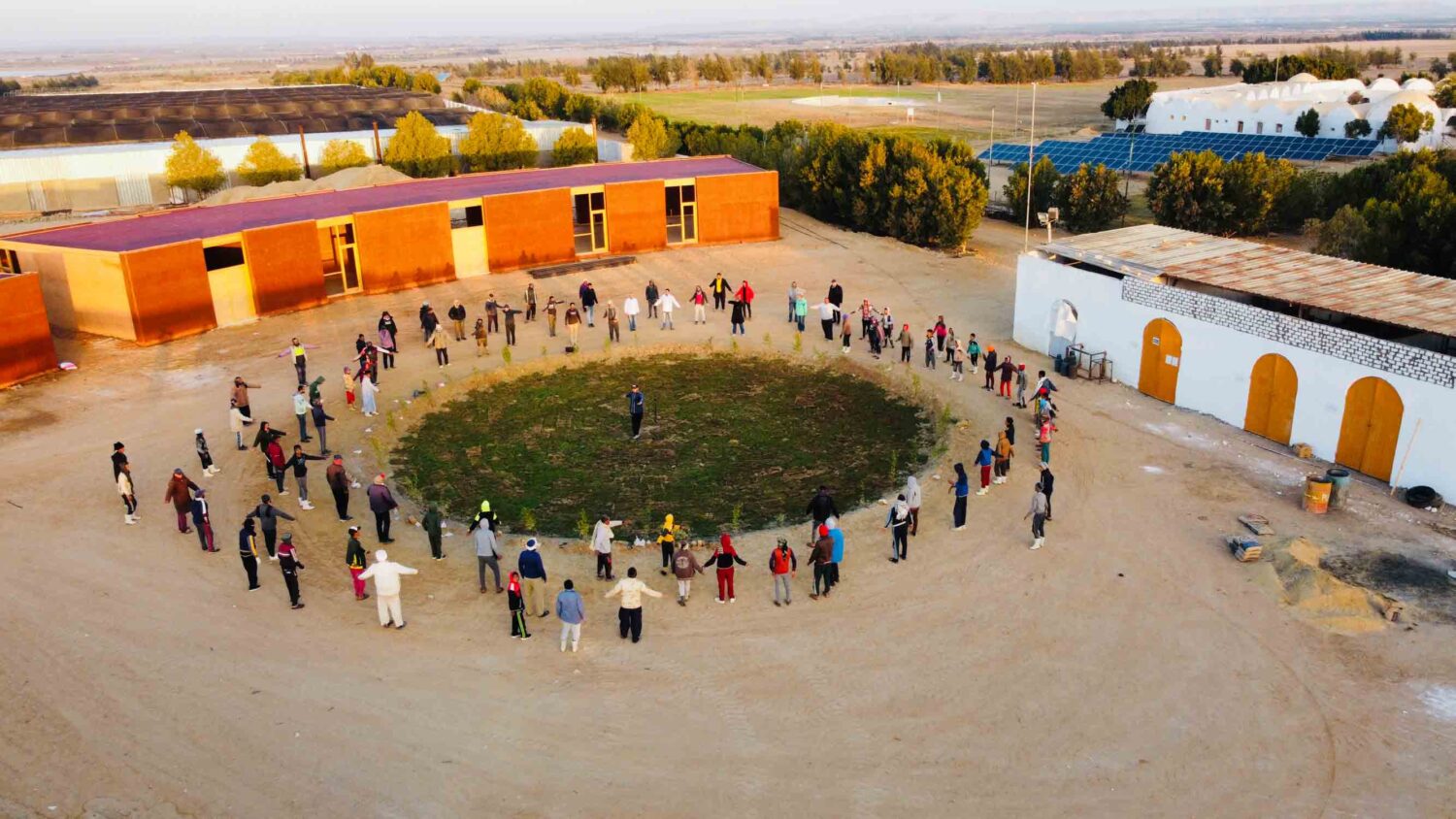
Valdinoci: You focus on all these projects from your position in the Holding management, try to keep all this in harmony. That is a huge task indeed. And then you go out into the world, even host various events at the COP27 climate conference, invite the alternative world to Sharm El-Sheikh. What is your compass for this inner and outer work?
Abouleish: Sekem would not exist without our networks, without our contacts, without our friends. And that is a process of give and take. Just as we learn a lot, we must of course also try to make a contribution and take what we have worked on into the world. That others might be inspired by it or have questions or improve it or, or, or. That is why from the very beginning, not only in recent years, we have always seen great value in connecting with our partners and friends, our business, cultural and social partners. You’ve seen it here, after all. Angela Hoffmann is constantly on the road in Africa, others are on the road in other fields. We also try, of course, to assist where there is the most experience, interest and knowledge. So that everyone, and especially of course the Future Council members, is really in a constant exchange and breathing in and out with the world. We do not see this as a burden, but as a support. The compass, of course, is that it serves our vision in some way.
Valdinoci: And at COP27 in November specifically, maybe you can link that with a call as to who should come, how can one contribute?
Abouleish: The COP27 this year in Sharm El-Sheikh, this 27th climate conference since 1995, is the biggest conference in the world every year. Up to 50,000 people will be arriving, including of course the representatives of the countries negotiating. But also civil society, women entrepreneurs, social entrepreneurs, researchers and so on. If we as a world have agreed that climate change is one of the greatest challenges of this century, we must of course also look at this: how can I contribute, what can I do in my environment and with my power? During this COP27 conference in Egypt it is our concern to create a platform where many people can meet who are trying in different movements to find alternatives, to reinvent the economy, education. The aim is for them to be able to exchange ideas so that synergies can be created, which are available here. So that we learn from each other. We are organising this now, right before COP27 in the Future Economic Forum that is taking place in Cairo from the 2nd to the 6th of November, in Sekem and at Heliopolis University. This will continue during COP27 in Sharm El-Sheikh from the 7th to the 18th of November. We also want to create a space there called ‹Solutions› where people can discuss the new ideas. This year, of course, we have made a special effort also to provide a platform for all the solutions from the southern hemisphere. Because what various initiatives in India, South America or Africa are doing is groundbreaking for the future of the whole world. We can learn from that too. Everyone who is interested, has a solution or would like to learn a solution and exchange ideas is warmly invited. Because this is an open forum, and we hope that more voices will be heard in the future, especially also from our movement, be it agriculture or the humanities. We have traditionally been under-represented in such forums and still are. I think we have a responsibility here. We should not underestimate the fruits that a spiritual seed can bear in the future. You simply have to sow thousands of times in order to reap something in the future.
Sekem in Figures
Sekem Holding Sekem Treuhand gGmbH holds just under 60% of the shares in Sekem Holding. Other shareholders are EcoTec Holding, GLS Beteiligungs AG, Oikocredit and Triodos as well as the Abouleish Foundation. A total of 1840 people work for Sekem Holding. About 40% of their children go to Sekem educational institutions. Of the staff, 40% work in agriculture, 30% in the processing of agricultural products, approx. 10% in the construction division, approx. 10% in the hotel and catering division, approx. 5% in the sustainability and certification division.
Agricultural Land: With the 200 hectares on the parent farm and another four Sekem farms in different regions in Egypt, over 2500 hectares are farmed biodynamically. Sekem cooperates with 26,000 smallholders who farm 20,000 hectares biodynamically or organically.
Sekem Development Foundation: A total of 250 people work in the facilities from crèche to vocational school and adult education. The Sekem schools based on Waldorf education have about 650 pupils. In three theatres at different locations we organise and produce about 150 events every year.
The Sekem Medical Centre: provides medical care not only for Sekem staff but also for the 30,000 inhabitants of the 13 neighbouring villages. The total budget for 2021 was three million euros. Of this, 50% came from Sekem Holding, 25% from donations and 25% from grants, mainly through research projects with the EU.
Heliopolis University: From the beginning, the university was part of the Sekem idea in the overall concept. Heliopolis University opened in 2012 and today has five faculties: Pharmacy, Business & Economics, Engineering, Physiotherapy, Organic Agriculture. A total of 267 academic staff work there, 113 of them men and 154 women. Today, the university has 2825 students, 60% of whom are women. The currently biggest faculty is Pharmacy with 1171 students and Physiotherapy with 1164 students. The total budget for 2021 was approximately two million euros, 70% of which was generated through tuition fees, approximately 20% from donations for scholarships and 10% from grants.
Title picture Herb field of Sekem’s Wahat Oasis
Translation Christian von Arnim

